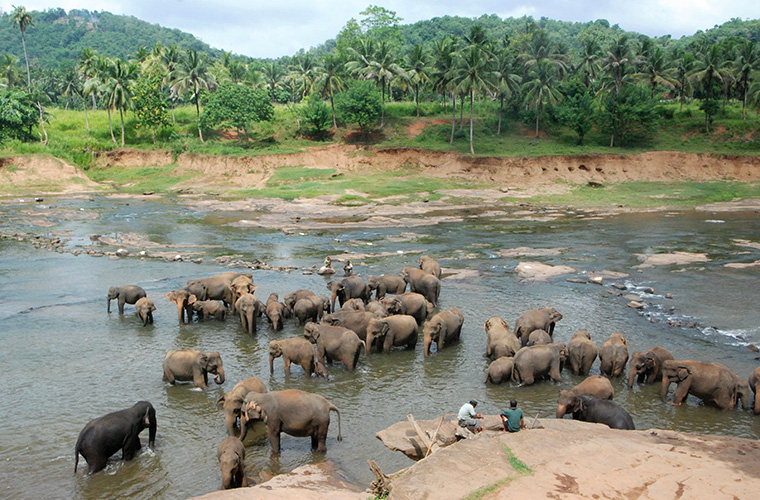Gimlette, John. Elephant Complex: Travels in Sri Lanka, Alfred A. Knopf, New York, 2016 (339pp.illus, maps, $28.95)
Master travel writer and London barrister John Gimlette’s journey to Sri Lanka began with a modest bus ride from his home in southwest London, where nearby he tell us, some 8,000 British Tamils live in Tooting, all originally from the town of Velvettithurai, and many of whom are members of tough urban gangs with names like “the Tamil Posse” or “the Jaffna Boys”. Unlikely as it sounds for England, these toughs had run amok on a beach in Norfolk in 2001 stabbing and beating holidaymakers. He’d been given lots of advice about Sri Lanka before leaving—that it was a lush land scrabbled with land mines left over from the long civil war (1983-2009), with jungle chocked full of rabid dogs, marauding elephants and poisonous scorpions. If there was one thing people loved telling him about Columbo, the island nation’s capital, it was that more people die there of snakebite than anywhere else in the world. “With hundreds of miles ahead, none of this was particularly encouraging,” Gimlette concludes.
What follows is an enchanting, intelligent and riotously engaging book that spins vividly through an island that is at once charmingly paradisiacal and innocently menacing. Sri Lanka, formerly known as Ceylon under its many colonial (Portuguese, Dutch, English, Japanese, then English again) conquerors, is a famously ancient civilization, a redoubt of Buddhist culture amid a Hindu world. In Colombo, Gimlette encounters a charming polyglot world, visiting ancient ruins and the old forts of the Dutch and English alike. At ease with everyone he meets, Gimlette demonstrates on every page his discerning eye for nuance, speaking with Test cricketers, slum-dwellers, British tea planters, academics, and the scions of wealthy Sinhalese families who’ve run the country for centuries. Driving with a guide along the southern coast, he views the ruins of the 2004 tsunami; farther along the coast the road peters out in sand dune and acacia scrub and he’s in the country of the legendary Vedda-forest dwellers, scrawny yogi-types who represent the aboriginal inhabitants with their magic incantations, potions and mystical theology. In the central mountains surrounding the ancient traditional Sinhalese capital Kandy, Gimlette forges intrepidly up narrow paths to view the huge reservoirs constructed more than two thousand years ago when Sinhalese hydraulic culture dwarfed that of nascent Rome.
Although the civil war between Tamil (Hindu) and Sinhalese (Buddhist) is over, it was a brutal struggle, with horrors on both sides and hundreds of thousands of deaths, slaughters in battle, suicide bombings, and massacres. In the hardscrabble towns along Sri Lanka’s west coast—towns like Karaitvu, Trincomalee and Mullaitivu, Gimlette wanders amid the unmarked graves of the combatants. Despite a decade of peace, the Sri Lankans seem not to have come to terms with the past. There seem no signs they intend to dredge it up now in the name of “reconciliation”, as did the South Africans.
Part of the glory of reading Gimlette is his colorful language, as captivating as travel writing can be: Writing about a Dutch fort– “It wasn’t easy to take it all in: the sky full of stone and parallel lines; a great pentagon of defenses, sheer, colossal, and technically perfect; twenty-two hectares of ravelins and glacises, and ramparts up to ten meters thick.” And then one day, Gimlette grabs a bedraggled train out of Colombo headed for the town of Ambalangoda, partway to the highlands: “The train wobbled out of Colombo and was soon amongst sawmills. Pencil-scented breezes gushed in through the windows and at last the carriage began to cool. The Marxists had worked through the woodwork, and covered everything in stickers. The man next to me was a healer, with a briefcase of unguents and stones. He said nothing until a man appeared out in the sawdust, beating a dog. “An unfortunate sight, no? But our dogs here are dirty.” “Can’t they be culled?” Gimlette asked him. The healer winced. “Killed? That would be against our beliefs.” On this particular trip, Gimlette learns that ginger is the best cure for colds, and wild lily for baldness. A man must never appear before his superior with his hair down, or with his sarong drawn up. There are omens everywhere. Nor should you swim at twilight. Those who become possessed need to make offers of puttu, or fried food, and rooster’s blood. The people of Colombo are horrified by the magicians, but wouldn’t use anyone else.
Gimlette, winner of the Shiva Naipaul Memorial Prize and the Wanderlust Travel Award, not to mention a Stanford Dolman Travel Book of the Year Award for “Wild Coast”, his wonderful last book, has taken on the mantle of “best” travel writer last worn by the likes of V.S. Naipaul and Paul Theroux. Like all great travelers he is intrepid and fearless, sharp-eyed and open to experience. He strips away veneer and penetrates every page with the lucidity of his opinions. Witty, gregarious, patient and humble, Gimlette practices his trade with the same ornery genius as Robert Byron, and with the same knowledge of architecture, history and art. Despite the grayness of his visage and his pot-bellied body, Gimlette has the courage of Marco Polo. On his last morning in Colombo he said his goodbyes—to Elmo, Ravi, and at dinner with Mohammed out at the golf club; he said goodbye to Professor Wijesinha at the Green Café, and met up with an investigative journalist who’d been on the run during the civil war, but now looked resplendent in an all-white suit. He also went to Gangarama, for one last moment with the temple’s elephant.
Then Gimlette flew home to his suburban house in southwest London.


